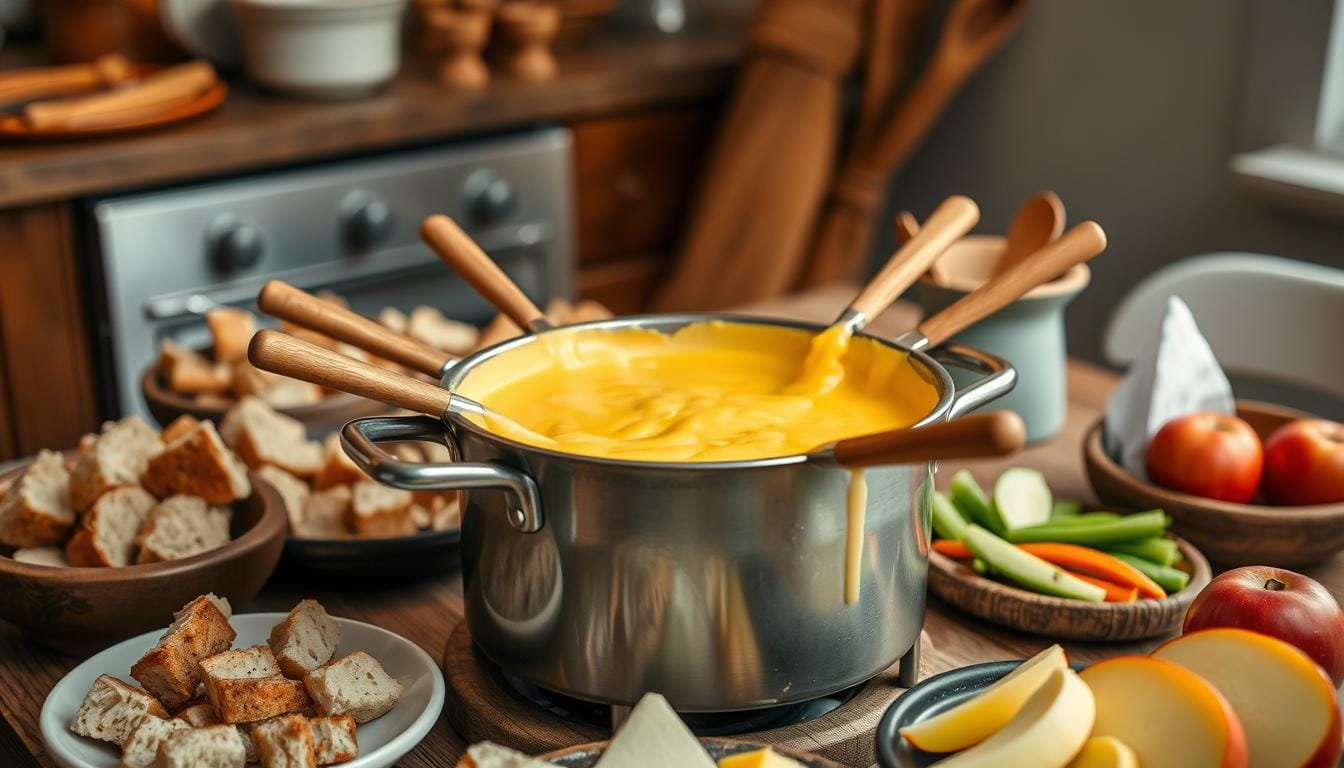Jump to Recipe
Imagine yourself and your closest friends gathered around a warm table on a chilly evening, ready to enjoy a traditional Swiss fondue experience. As you take turns dipping crusty bread, crisp veggies, and tender meats into the bubbling pot, the smell of melted cheese permeates the room.
In addition to being a delightful way to stay warm on a chilly night, throwing a fondue party is a memorable and participatory meal that brings people together.
I’ve been making fondue for a long time, so I’ve spent years honing my simple fondue recipe and methods to make the best cheese fondue at home. I’ll reveal my top tips for picking the ideal wine, blending cheeses, and preparing your fondue pot for a faultless and enjoyable evening in this comprehensive tutorial.
You’ll find all the advice you need to master the art of cheese fondue and wow your guests with this traditional Swiss dish, whether you’re a novice or an experienced cook.
Gathering the Essential Ingredients
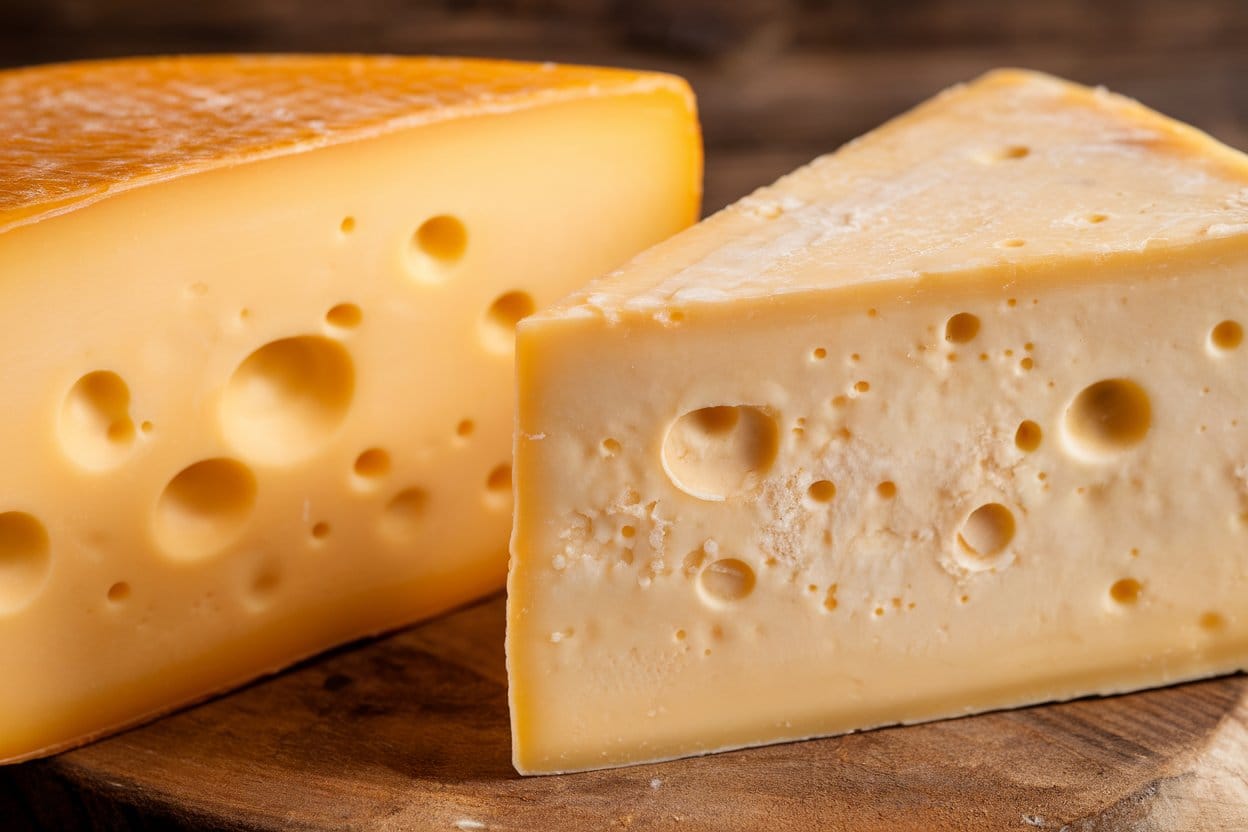
To begin creating your cheese fondue, make sure you have all the necessary ingredients. The secret to a great fondue is choosing the appropriate ingredients that blend well together to produce a dish that is flavorful, silky, and irresistible.
Selecting the Perfect Cheese Blend
My go-to recommendation for the ideal cheese for your fondue is a blend of Gruyère and Emmental. The base of a traditional fondue cheese mixture consists of these two Swiss cheeses.
Emmental contributes a mild, buttery flavor with a hint of nuttiness, while Gruyère adds a rich, nutty, and slightly sweet flavor. When combined, they make an exquisitely balanced fondue that will have your guests begging for more.
Choosing the Right Wine for Your Fondue
Selecting the right wine for your fondue is equally crucial as selecting the cheese. For the cheese to have a smooth, velvety texture and to counterbalance its richness, a dry, acidic white wine is necessary.
A traditional fondue wine, such as a dry Riesling or Sauvignon Blanc, is what I like to use. These wines’ acidity is just right to cut through the cheese and keep the fondue from getting too thick or greasy.
Additional Flavourings and Seasonings
Even though the cheese and wine steal the show, you can elevate your fondue by adding a few more spices and flavorings. My top picks for optional ingredients are as follows:
- Kirsch: A transparent cherry brandy that stabilizes the fondue mixture and adds a hint of fruitiness.
- Garlic: A subtle garlic flavor can permeate the entire fondue dish if you rub a chopped garlic clove inside the pot before adding the cheese.
- Nutmeg: Adding a pinch of freshly grated nutmeg can make your fondue warmer, a little sweeter, and smell better by adding a pinch of freshly grated nutmeg.
If you choose your cheese blend, wine, and other flavors with care, you’ll be well on your way to making a cheese fondue that your guests will remember and want more of.
Preparing Your Fondue Setup

Having the proper tools is essential for a flawless and pleasurable fondue experience before you begin melting your cheese and dipping your favorite bread and veggies.
In this section, I’ll walk you through the process of choosing the ideal fondue pot and assembling your fondue burner to ensure that your cheese fondue stays at the perfect temperature throughout your meal.
Choosing the Right Fondue Pot
There are a few different kinds of fondue pots, and each has its own pros and cons for you to consider. Clay and cast iron are two common materials used to make fondue pots.
- Cast iron fondue pots are known for being excellent at keeping and spreading heat, which means they’ll keep your cheese fondue at a steady temperature. Not only that, but they are also strong and last a long time, so fans should buy them. On the other hand, cast iron pots can be heavy and require proper seasoning to prevent rusting.
- On the other hand, ceramic fondue pots are lighter and often look better because they come in many colors and patterns. These pots are easy to clean, but they may lose heat faster than cast iron pots, making fondue cool faster.
You can use both cast iron and ceramic fondue pots, depending on your personal taste and specific needs. When choosing a fragrance set, think about things like the number of people you’re inviting, how much heat you want to keep in, and the overall look you want to achieve.
Setting Up the Fondue Burner
After picking out your fondue pot, set up your fondue burner. Fondue burners come in a number of styles, such as electric burners, tea light candles, and gel fuel burners. There are pros and cons to each type of hob, so think about your needs and preferences when making your choice.
Always follow the manufacturer’s instructions and put safety first when setting up your fondue burner. Keep your hob away from things that can catch fire, as well as out of reach of children and pets.
Place it on a stable, heat-resistant surface. Use the appropriate fuel for fondue when using a gel fuel burner, and always extinguish the flame completely after use.
If you take the time to pick out the right fondue pot and set up your fondue burner correctly, your cheese fondue will stay at the perfect temperature for the whole meal. This will give you and your guests a delicious and memorable fondue experience.
Step-by-Step Guide to Making Easy Cheese Fondue
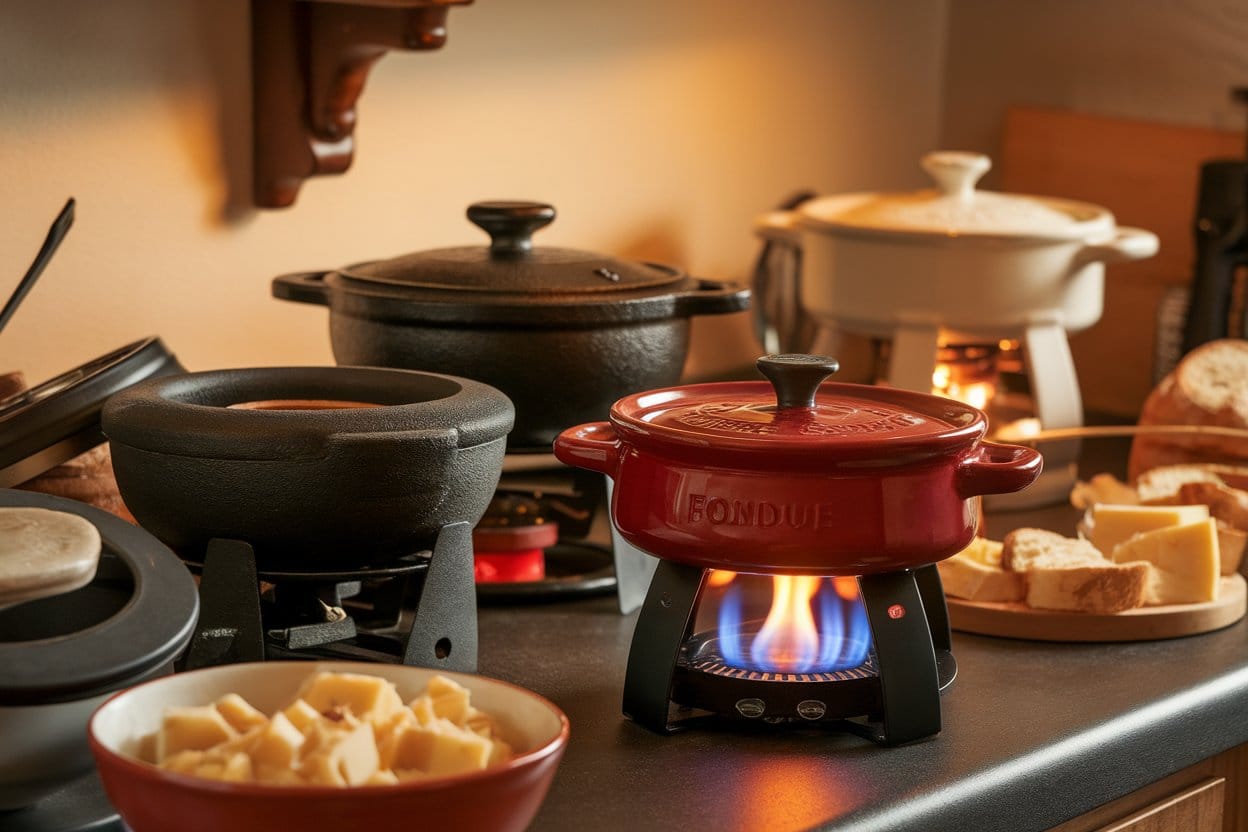
Creating a tasty cheese fondue is a simple process that only needs a few handy steps. Here, I’ll walk you through the steps and give you my best advice for always getting the perfect fondue consistency.
Grating and Mixing the Cheese
First, use a box grater or food processor to grate the cheese blend you chose. Using a cheese grater to melt the cheese quickly and evenly keeps the fondue from becoming lumpy. Once the cheese is grated, add a tablespoon of corn flour and mix it in. This will help the fondue stay stable and make the texture smooth and silky.
Preparing the Wine Base
Next, get the wine base for your fondue ready. Bring the white wine you want to use to a slow simmer over medium heat in a fondue pot or a saucepan with a heavy bottom. The acid in the wine balances out the richness of the cheese and keeps the fondue from breaking up.
Incorporating the Cheese and Achieving the Perfect Consistency
While the wine base is simmering, mix the grated cheeses and add them to the pot one handful at a time. Use a fork or wooden spoon to thoroughly mix each handful of cheese into the fondue before adding the next. This method of slowly adding cheese and stirring constantly will result in a smooth and luxurious fondue.
Over medium-low heat, keep stirring the fondue until all the cheese has melted and the sauce is thick and shiny. If the fondue seems too thick, you can thin it out by adding a splash of extra white wine or a tablespoon of kirsch, a clear cherry brandy that makes the cheese taste better.
Once your cheese fondue reaches the right consistency, it’s ready to serve. Set the fondue pot over a low flame to keep the sauce warm and smooth while you eat.
Selecting the Best Dippers for Your Fondue
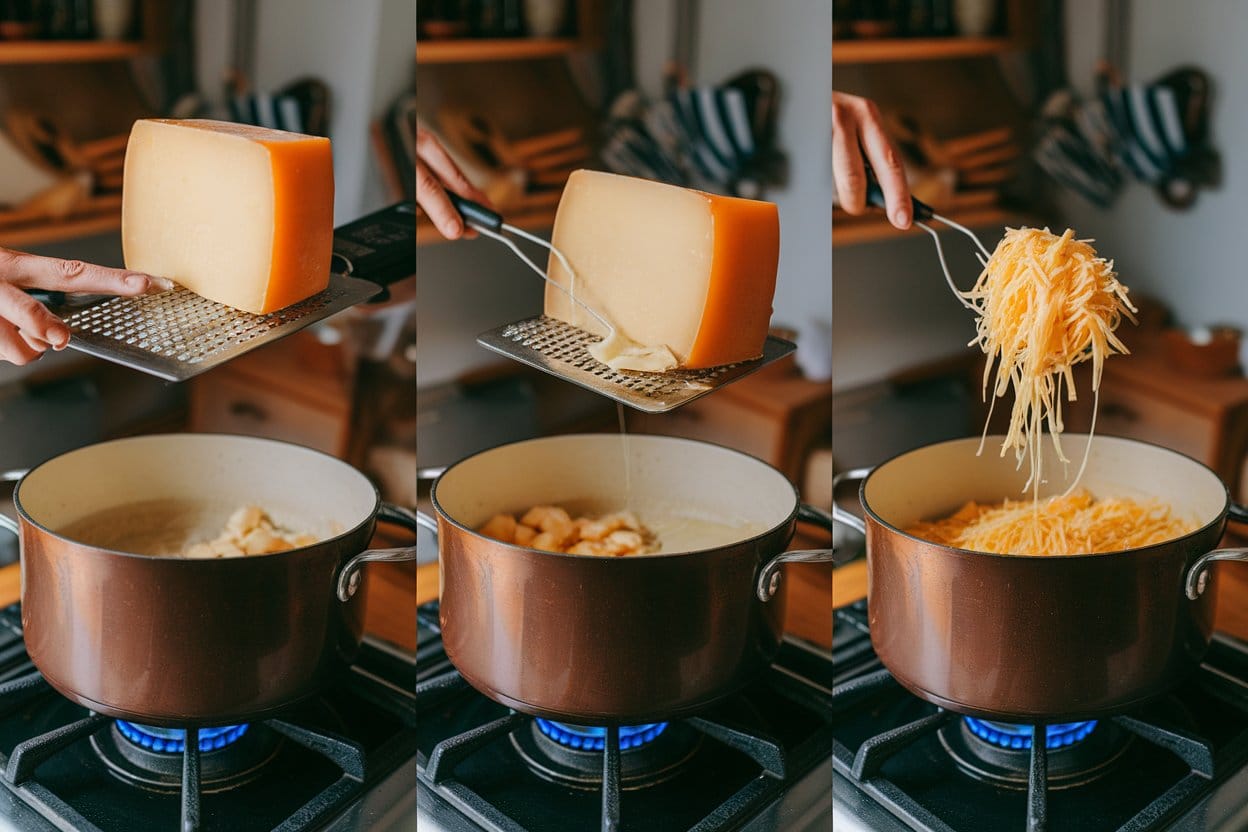
A lovely selection of dippers to go with the rich, velvety cheese is an important part of any fondue experience. Consider a variety of textures and flavors when choosing the dippers to pair with your preferred cheese to ensure the experience remains engaging.
Crusty bread cubes are a classic choice, and for excellent reason: they’re perfect for scooping up lots of melted cheese. Day-old bread, in my opinion, retains its shape better after dipping.
Add a variety of lightly blanched vegetables to your fondue spread to make it more balanced and fresh. You can choose broccoli florets, cauliflower, or asparagus spears, all of which go well with the rich cheese. You could add cherry tomatoes or sliced bell peppers to your platter to give it some color and sweetness.
Curried meats, like chorizo, prosciutto, or salami, go well with the creamy fondue because they are savory and salty. Cut them into thin slices and arrange them in a neat way on your serving board. Their bold flavors complement the rich, velvety texture of the melted cheese, creating a perfectly balanced bite. For a complete dining experience, consider finishing your meal with a decadent dessert, such as a sticky toffee pudding recipe, to leave a lasting impression on your guests. The sweetness of the dessert provides a delightful contrast to the savory notes of the fondue and meats.
Unexpectedly, you can also use fruit to dip items in fondue. Apples or pears that are tart, crisp, or lightly sweet go well with cheese because they are more refreshing.
When you’re making the sides for your fondue, make sure to cut them into small pieces that are simple to skewer and dip. On a platter or board, arrange your dippers in a stylish way to ensure there’s something for everyone.
Your fondue spread will be the highlight of any event if you carefully choose a variety of breads, vegetables, meats, and fruits. Guests will be able to mix and match the flavors and enjoy each one.
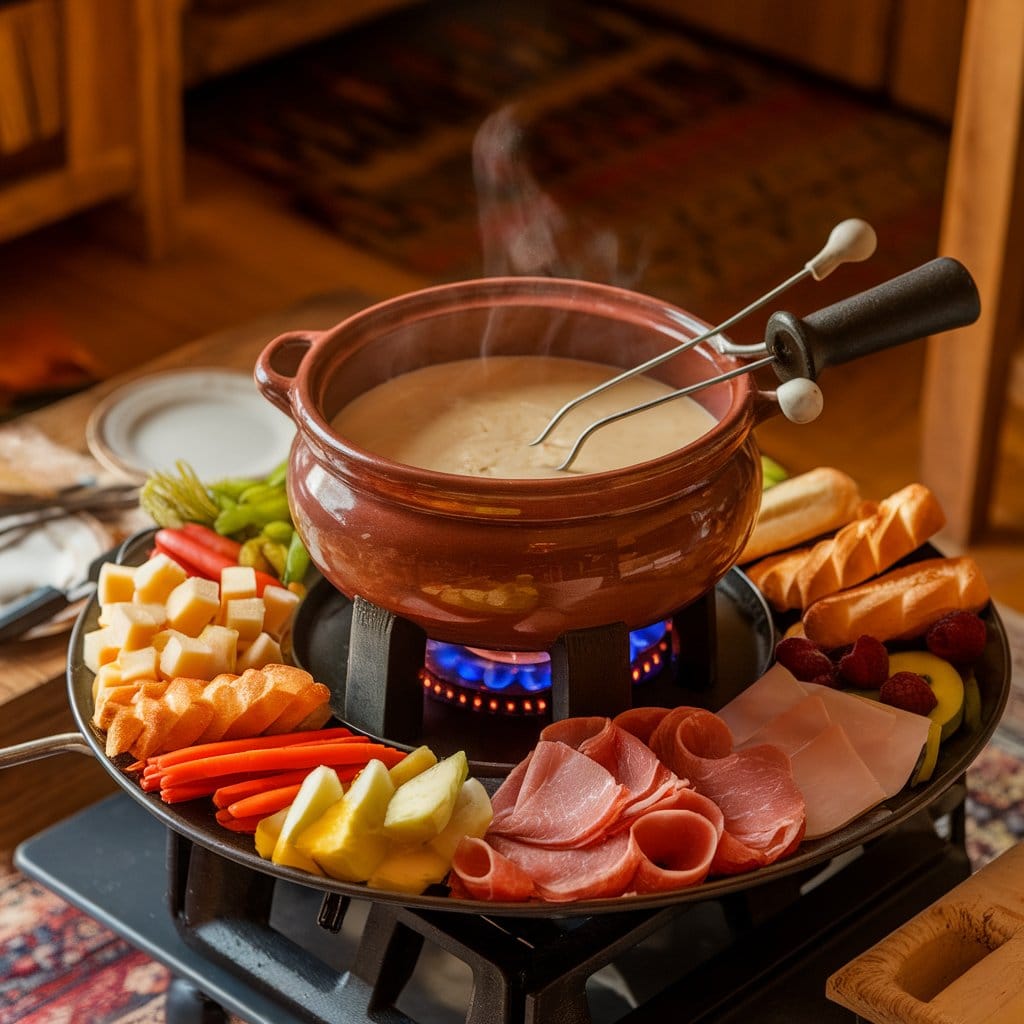
Classic Swiss Cheese Fondue
Ingredients
Method
- Prepare the Cheese: Grate the Gruyère and Emmental cheese, then mix with cornflour to help stabilize the fondue.
- Prepare the Pot: Rub the inside of the fondue pot with the halved garlic clove for a subtle garlic flavor.
- Heat the Wine: Pour the white wine into the fondue pot and gently bring it to a simmer over medium heat.
- Add the Cheese: Gradually add the cheese to the pot, one handful at a time, stirring constantly until smooth and creamy.
- Add Flavorings: Stir in the Kirsch (if using) and a pinch of grated nutmeg for extra depth of flavor.
- Serve: Place the fondue pot over a low flame to keep the cheese warm and serve with a variety of dippers like bread cubes, veggies, meats, and fruits.
Notes
- For a smoother fondue, stir in a figure-eight motion and keep the temperature low.
- Day-old bread works best for dipping as it holds its shape better.
- Keep the fondue over a gentle heat to maintain its creamy texture throughout the meal.
FAQ
What’s the best cheese combination for a classic cheese fondue?
If you want to make a classic cheese fondue, I suggest mixing Gruyère and Emmental cheeses. The slightly sweet and nutty taste of Gruyère goes well with the mild and buttery taste of Emmental to make a delicious and well-balanced fondue.
Can I use any type of wine for my cheese fondue?
You can try different wines, but I think you should use a dry, acidic white wine like Riesling or Sauvignon Blanc. These wines help keep the fondue stable and keep the cheese from breaking up or getting oily. When making cheese, don’t use sweet or red wines because they can make the cheese taste too strong.
Is it necessary to use a fondue pot, or can I make it in a regular saucepan?
Any saucepan will work to make the fondue, but a fondue pot is the best for the real experience. It is the job of a fondue pot to keep the cheese at a steady temperature so it doesn’t burn or get too cold. Interacting with others while eating can also improve the atmosphere.
How do I achieve the perfect fondue consistency?
To get the right consistency for the fondue, you must slowly add the grated cheese to the wine base while stirring all the time in a figure-eight pattern. This method makes it easier to mix the cheese evenly and keeps it from clumping. You can add a little more wine to thin out your fondue if it gets too thick. If it’s too thin, add more cheese until you get the right consistency.
What are some creative dipper ideas beyond the classic bread cubes?
Even though bread cubes are a classic dip for fondue, I like to offer a range of other foods to keep things interesting. Some of my favorite choices are lightly blanched broccoli and cauliflower. So are cured meats like salami and prosciutto, as well as fresh fruits like apples and pears. The important thing is to have different tastes and textures that go well with the rich, creamy cheese fondue.
Can I make cheese fondue in advance?
Even though cheese fondue tastes best when it’s hot, you can make the grated cheese mixture ahead of time and put it in the fridge until you’re ready to cook. However, I don’t recommend preparing the fondue in advance, as it may separate or become grainy when reheated.

